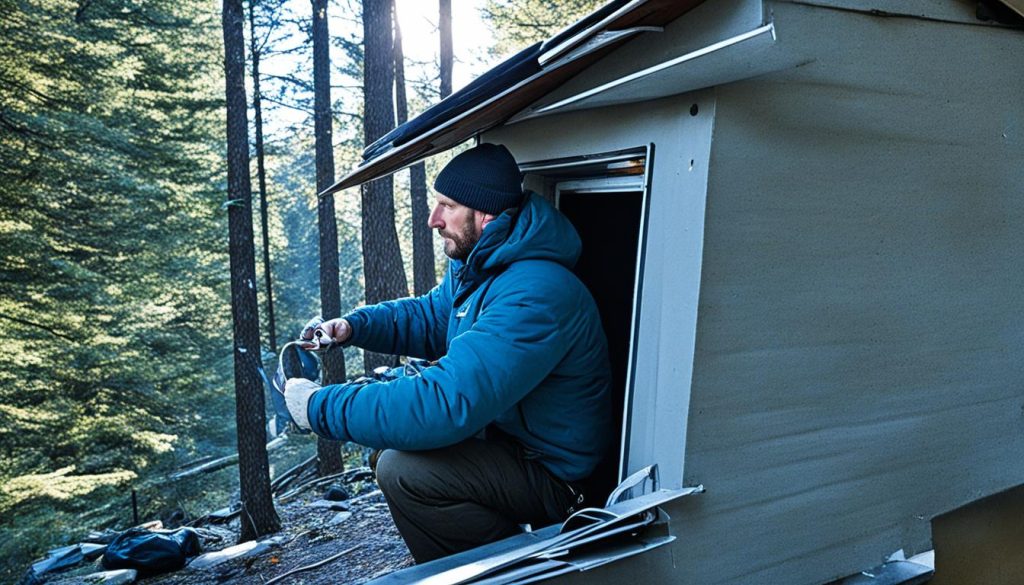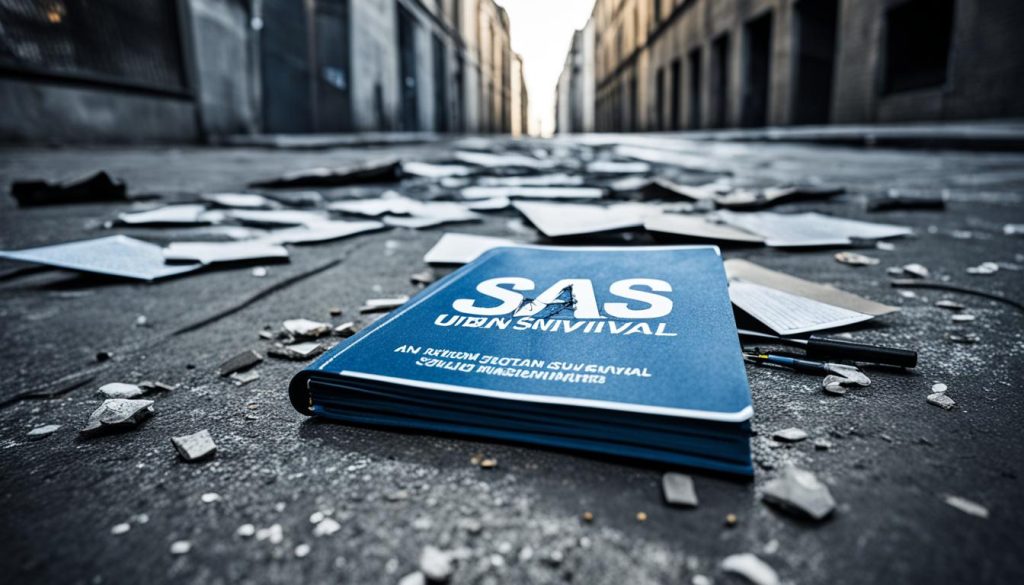Did you know that 81% of the U.S. population now lives in urban areas? As more and more people flock to cities in search of opportunities, it becomes increasingly important to develop advanced urban survival skills to navigate the unique challenges and threats posed by city life.
In this section, I will explore crucial urban survival techniques that can help individuals ensure their safety and resilience in urban environments. Whether it’s a natural disaster, civil unrest, or a terrorist attack, being prepared and equipped with the right skills is key to survival.
Key Takeaways:
- Living in urban areas presents unique challenges and threats that require advanced urban survival skills.
- Developing urban survival skills is crucial for navigating modern city threats.
- Honing these skills can significantly improve your emergency preparedness in the city.
- Being proactive and knowledgeable is fundamental to surviving and thriving in urban environments.
- Stay tuned to learn the top 5 urban survival tips and techniques that you can implement today.
Top 5 Urban Survival Tips
When facing a crisis in an urban environment, having the right survival skills can make all the difference. In this section, I will share the top 5 urban survival tips that can help you navigate through challenging situations and increase your chances of survival.
- Move quickly: Time is of the essence in urban survival scenarios. Before exit routes become crowded or blocked, it’s crucial to move swiftly and decisively. Stay alert and aware of your surroundings to identify the safest and quickest escape paths.
- Be prepared for environmental hazards: Cities can come with their fair share of environmental hazards, such as pollution, extreme weather, or industrial accidents. Make sure you have proper protective gear, such as masks, gloves, or waterproof clothing, to mitigate the risks.
- Adopt the “grey man/woman” approach: Blend in with your surroundings to avoid drawing attention to yourself. Dress in neutral and non-flashy clothing, avoid displaying expensive items, and practice good situational awareness to minimize the chances of becoming a target.
- Look like a threat: While adopting a low-profile can be effective in some situations, there may be times when appearing confident and assertive is necessary. Maintain good posture, use assertive body language, and project a no-nonsense attitude to deter potential attackers.
- Follow your instincts: When faced with a crisis, it’s easy to get caught up in the panic of the crowd. However, it’s important to trust your instincts and make decisions based on your own assessment of the situation. Sometimes, going against the crowd can lead to safer outcomes.
By implementing these urban survival tips into your preparedness plan, you’ll be better equipped to handle the challenges of an urban environment and increase your chances of survival.

Comparison of Urban Survival Tips
| Survival Tip | Benefits |
|---|---|
| Move quickly | Minimizes the risk of being trapped or encountering obstacles |
| Be prepared for environmental hazards | Protects against health risks and increases overall readiness |
| Adopt the “grey man/woman” approach | Reduces the likelihood of being targeted or attracting unwanted attention |
| Look like a threat | Deters potential attackers and increases personal safety |
| Follow your instincts | Empowers decision-making and promotes individual safety |
The SAS Urban Survival Guide
In this section, we will explore the SAS Urban Survival Guide, a comprehensive resource that provides practical advice on how to stay safe in urban environments. The guide covers a wide range of topics, including self-defense techniques, home security systems, and coping with natural disasters. The author, John “Lofty” Wiseman, draws from his extensive experience as a chief survival instructor for the SAS to offer valuable insights and strategies for surviving in the urban jungle.
Urban environments can present unique challenges and threats that require specialized knowledge and skills to navigate. The SAS Urban Survival Guide combines real-world expertise with practical tips and techniques to help individuals stay safe and secure in bustling cityscapes. Whether you are a city dweller, a frequent traveler, or simply looking to enhance your emergency preparedness skills, this guide offers invaluable advice to ensure your safety in the urban jungle.
One of the key areas covered in the SAS Urban Survival Guide is self-defense. Wiseman shares techniques for personal protection and avoiding dangerous situations, empowering readers to effectively respond to potential threats. The guide also delves into the importance of situational awareness and how to assess and mitigate risks in urban settings.
Another vital aspect discussed in the guide is home security systems. With urban living comes the need for safeguarding one’s residence and belongings. The SAS Urban Survival Guide offers insights into bolstering home security measures, including tips on securing entry points, installing surveillance systems, and developing emergency plans for intrusions or emergencies.
Contents of the SAS Urban Survival Guide
| Section | Topics Covered |
|---|---|
| 1 | Understanding the Urban Jungle |
| 2 | Strategic Situational Awareness |
| 3 | Self-Defense Techniques |
| 4 | Home Security Systems |
| 5 | Coping with Natural Disasters |
The SAS Urban Survival Guide also equips readers with essential knowledge on handling natural disasters. From earthquakes to hurricanes, urban environments can be significantly impacted by such events. The guide provides guidance on preparing for and responding to various natural disasters, including tips on stockpiling essential supplies, creating emergency communication plans, and identifying safe shelter options.
By consulting the SAS Urban Survival Guide, individuals can gain valuable insights and strategies for staying safe in the urban jungle. The combination of expert knowledge, practical techniques, and real-world experiences make this guide an essential resource for anyone seeking to enhance their urban survival skills and emergency preparedness capabilities.

The Core Four: Shelter, Water, Fire, and Food
When it comes to urban survival preparedness, there are four key priorities that should be at the top of your list: shelter, water, fire, and food. These core elements form the foundation of survival in any urban environment and are essential for your well-being and overall chances of survival. Let’s delve into each of these priorities and explore their significance in more detail.
Shelter:
Having a proper shelter is crucial for protecting yourself against the elements and ensuring your safety in an urban survival scenario. When seeking shelter, consider factors such as insulation, durability, and concealment. Look for locations that provide protection from extreme weather conditions and potential threats. Urban areas offer various options for shelter, including abandoned buildings, underground structures, and makeshift hideouts. It’s important to assess the structural integrity of any chosen shelter and be prepared to adapt to changing circumstances.
Water:
Water is a vital resource that should never be underestimated in urban survival situations. It is essential for hydration, hygiene, and basic survival needs. In an urban environment, water sources may be limited, contaminated, or unavailable. Therefore, it is important to have a plan in place for sourcing and purifying water. Learning techniques such as rainwater collection, water filtration, and water purification can ensure a safe and adequate water supply when faced with scarcity.
Fire:
Fire serves multiple purposes in an urban survival situation. It provides warmth, helps with cooking, purifies water, and can even serve as a signaling tool for rescue. Acquiring the ability to create fire in various environments is essential. Basic fire-starting techniques include using matches, lighters, or fire starters, along with knowledge of natural tinder, kindling, and fuel sources. Additionally, being aware of fire safety measures and practicing responsible fire management are important to prevent accidents and avoid drawing unnecessary attention.
Food:
In a prolonged urban survival scenario, finding a reliable food source becomes crucial. While the availability of food may be limited in urban areas, there are still options to explore. Engaging in hunting, fishing, gathering, and scavenging can provide you with sustenance. Urban environments may offer opportunities for foraging wild plants, fishing in bodies of water, or scavenging non-perishable food in abandoned buildings or stores. Acquiring knowledge of edible plants, basic hunting and fishing techniques, as well as food preservation methods, will enhance your chances of finding and securing food sources.
By understanding and prioritizing shelter, water, fire, and food, you can lay a solid foundation for urban survival. These core elements work together to ensure your safety, sustain your basic needs, and increase your chances of survival in any urban environment.
Remember, being equipped with the right urban survival gear can greatly enhance your preparedness and overall chances of survival. From multi-tools and portable water filters to compact stoves and lightweight shelters, there are various gear options available to suit your needs. Invest in high-quality, reliable gear that is designed specifically for urban survival scenarios to ensure your readiness for any situation.
Conclusion
In conclusion, advanced urban survival skills are crucial in navigating modern city threats with confidence. By implementing the top 5 urban survival tips, utilizing resources like the SAS Urban Survival Guide, and focusing on the core four survival elements – shelter, water, fire, and food – individuals can significantly enhance their preparedness and increase their chances of survival in urban environments.
Continuously educating oneself and practicing survival techniques are essential to maintaining effective emergency preparedness. Staying updated on the latest urban survival gear and techniques is also crucial to adapt to evolving urban threats. Remember, the key to advanced urban survival lies in being proactive, adaptable, and knowledgeable, which is essential for not only surviving but also thriving in any situation.
As the landscape of urban environments continues to change, it is important for individuals to stay vigilant, assess potential risks, and develop strategies to mitigate them effectively. Empower yourself with advanced urban survival skills, using the strategies and techniques discussed in this guide, and you can confidently navigate any urban setting with the knowledge and skills to ensure your safety and well-being.
